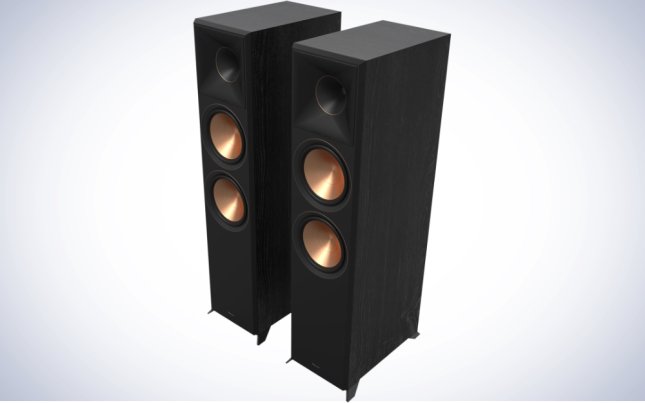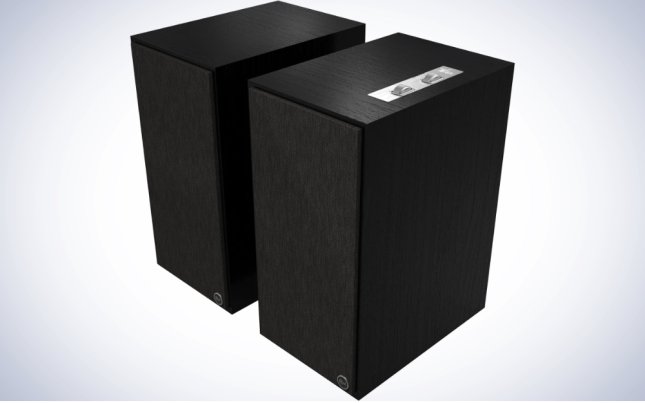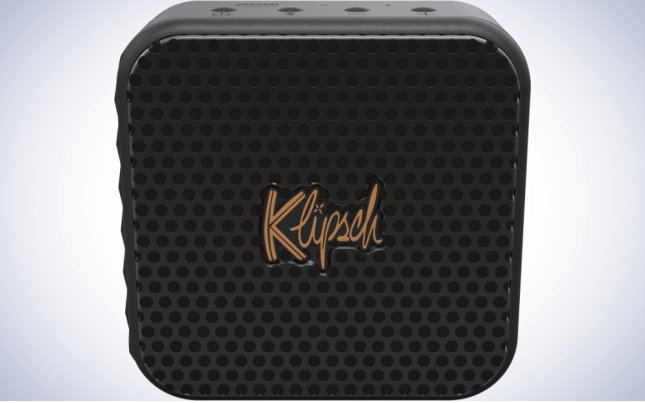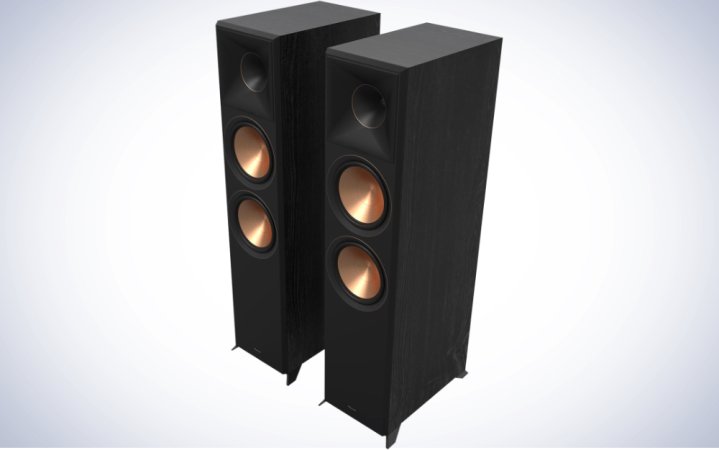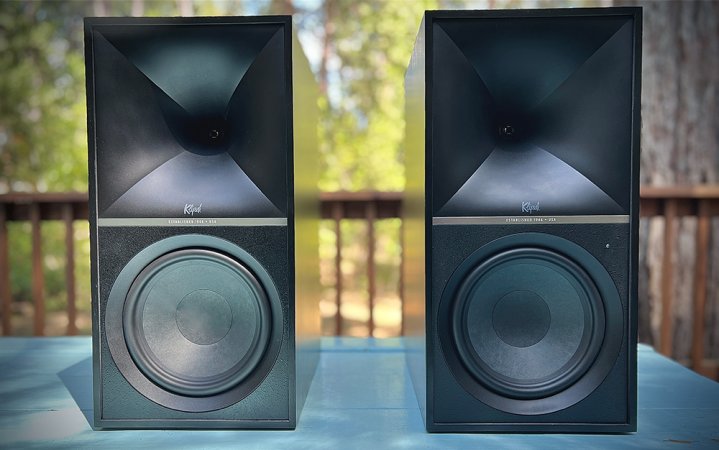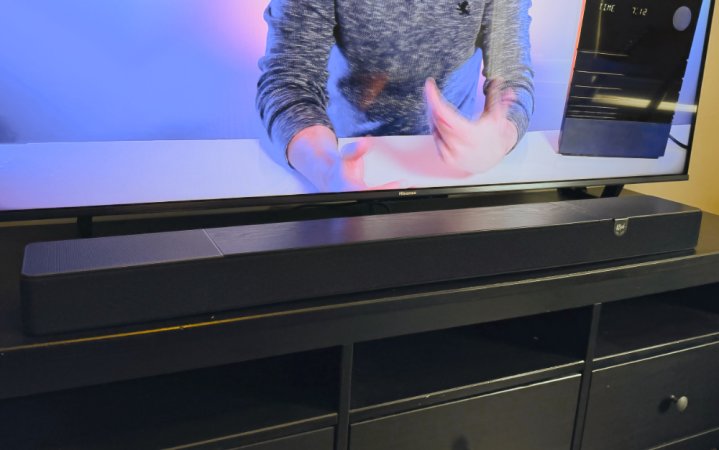We may earn revenue from the products available on this page and participate in affiliate programs. Learn more ›

Klipsch speakers have impressed the audio world since the company’s inception in 1946, and the tradition of continually releasing innovative hardware has continued for the past 78 years. In recent years, Klipsch has branched out from passive floorstanding speakers—like our best overall, the RP-8000F—into making powered bookshelf speakers and portable Bluetooth speakers. The company’s attention to high-energy acoustics and dual focus on both audio quality and value have helped it stand out even with increased competition from both new and legacy speaker makers. The best Klipsch speakers will extract all the dynamic details of your music, movies, and video games at home and on the go.
- Best overall: Klipsch Reference Premiere RP-8000F II
- Best splurge: Klipsch The Nines
- Best portable: Klipsch Nashville
- Best soundbar: Klipsch Flexus CORE 200
- Best budget: Klipsch Austin
How we chose the best Klipsch speakers
Klipsch makes an enormous number of speakers, so winnowing down the best required us to take into consideration the most common ways people will use them. After careful consideration, we decided on portable speakers for on-the-go listening, passive and active speakers for music listening, and a soundbar for those who want a more compact home theater system. Our recommendations are based on a mix of hands-on testing and research to determine the best choice in each given category.
The best Klipsch speakers: Reviews & Recommendations
Ready to set up a home theater or upgrade from a pair of speakers with toasted tweeters and worn-out woofers? It’s time to hear what your music, movies, and games really sound like with a set of Klipsch speakers.
Best overall: Klipsch Reference Premiere RP-8000F II
Pros
- Triple driver audio system
- Aluminum feet designed to absorb vibrations
- Aesthetically pleasing
Cons
- Price
Specs
- Powered: No
- Dimensions: 22.04 x 14.96 x 48.42 inches
- Weight: 61.4 pounds
- Price: $1,198
Klipsch’s Reference Premiere RP-8000F II speakers typify what makes the company’s audio hardware so impressive and revered. Yes, the floorstanding speakers are large, but each cabinet houses multiple drivers: a pair of eight-inch woofers and one-inch tweeters. These woofers are made from a cerametallic material, which Klipsch says maximizes their efficiency while minimizing the potential for distortion. In addition, specially designed bass ports allow for more extension with less noise. This is especially important because the woofers will be responsible for accurately representing the dynamic width of midrange and low frequencies unless you connect a subwoofer to your home audio system.
The speakers’ titanium LTS tweeters and vented housings are mounted onto Tractrix horns, a proprietary component designed by Klipsch to ensure detailed, accurate reproduction. The silicone composite horn is flared so that the tweeter’s sound is properly dispersed outward. Klipsch says this design is an efficient way for treble sounds to always clear the enclosure with deliberate directivity and minimum reverb from wall reflections, lowering the probability of harsh harmonics and sibilant sounds.
If you like to listen to your music loud, the RP8000F II’s cast aluminum feet may be a most appealing feature. They keep the speaker from sitting flush on the floor, so vibrations from loud sounds don’t rattle the cabinet, which causes distortion. While these speakers were designed for stereo listening, each one has a pair of connectors toward the top of the cabinet that allows you to connect one of Klipsch’s RP-500SA upward-firing surround sound speakers to them. This, along with a switchable crossover setting, will allow you to listen to music mixed in Dolby Atmos without hooking those additional speakers up to your AV receiver. Klipsch includes a pair of “jumper cables” with the RP8000F IIs for this purpose. It’s great to know there’s a built-in upgrade path if you’re starting to build a home theater system and are starting with these speakers.
Yes, they’re expensive, but there’s a reason Klipsch has labeled the RP-8000F IIs as reference speakers. We’ve seen them in action at the Audio Advice Live trade show, and they’re well worth the price if you have enough space for a pair of floor-standing speakers and care about premium sound. We were so impressed we’ll get getting a pair in for review in the coming months.
Best splurge: Klipsch The Nines
Pros
- Enormous woofers for a relatively compact cabinet (compared to a tower speaker)
- Designed for both analog and digital music listening
- Loaded with inputs
Cons
- Price
Specs
- Powered: Yes
- Dimensions: 13.38 x 9.5 x 19.13 inches
- Weight: 66 pounds
- Price: $1,499
The Nines is an all-in-one audio system that blew us away during our time with them. Klipsch outfitted its powered speakers with a single eight-inch woofer and one-inch tweeter mounted onto a Tractrix horn. While they don’t have the exact same components as the Reference Premiere RP-8000F IIs, they share the same DNA, if not the dimensions. You’ll get enormous sound—both in depth and volume—from speakers just over a foot-and-a-half tall.
Part of The Nines’ appeal is their versatility. Like the smaller Fives and Sevens, these powered speakers have an RCA phono input, USB port, HDMI port, optical audio port, and subwoofer output, meaning you can connect them to virtually any component. It’s conceivable that one could hook up a turntable, TV, and computer to The Nines simultaneously and use them as home audio, home theater, and computer speakers with the flick of a switch.
And because The Nines have a built-in phono stage, you won’t need an external phono preamp or AV receiver for them to be excellent turntable speakers. Discerning digital music listeners will be able to listen to 24-bit 192kHz natively through any of its digital inputs, or stream compressed audio to the speakers wirelessly over Bluetooth. This is it if you’re looking for one set of speakers that can fit into any audio system.
Best portable: Klipsch Nashville
Pros
- 24-hour battery life
- Can connect to up to 10 additional Klipsch speakers
- Reverse charging
Cons
- Bluetooth only
Specs
- Powered: Yes
- Dimensions: 3.19 x 3.07 x 7.01 inches
- Weight: 2.4 pounds
- Price: $149
Klipsch’s Nashville is the mid-sized option in the company’s “Music City” portable speaker series, and it delivers a lot for its small size. The speaker has a pair of 2.25-inch full-range drivers behind its signature copper logo and black grille—one front and one rear-firing so it can be enjoyed from any angle. The Bluetooth speaker’s drivers are augmented by a pair of bass radiators for cleaner low-end response. There aren’t any onboard tone controls, but you can tweak how the Nashville sounds using the Klipsch Connect app on iOS and Android if you’d like to dial in different frequencies or adjust its EQ to suit the type of music you like listening to the most.
The Nashville supports Bluetooth 5.3, the latest most stable version of the wireless audio protocol, though it only connects to smartdevices and computers via the baseline SBC codec. It does, however, support a feature called “Broadcast Mode” that allows you to connect it to up to 10 other Klipsch speakers. This feature will come in handy if you’d like to create a whole-home wireless audio system or just want to be able to stream the same track to two places during a larger party. Broadcast Mode works over Bluetooth, as the Nashville doesn’t support Wi-Fi audio streaming. Similarly, there’s no Aux input on this speaker, which means it’s Bluetooth or bust. We’re pleased that the Nashville has an IP67 rating, so it won’t get damaged when exposed to water or dust.
Klipsch says the Nashville supports up to 24 hours of music playback per charge, but the amount you get will be dependant on your listening volume and whether Broadcast Mode is engaged. The speaker charges via USB-C, and you can use its charging port to top up the batteries in your other devices by plugging them in. Using the Nashville as a power bank will deplete its battery a lot more quickly, but the feature is useful in a pinch.
Of course, none of this is worth a dang if the speaker ain’t got that twang. Luckily, the Nashville’s 60Hz to 20kHz frequency response is surprisingly robust for a speaker its size. At 50 to 60 percent volume, the speaker maintains pleasingly throaty dynamics with minimal distortion, thanks to its DSP. Things start getting iffy above that, so if it’s volume you seek, look to the bigger $299 Detroit speaker (the elongated speaker in the image above). Playback is in mono but there’s still a good sense of instrument separation, aided by some EQing in the app to bump tight bass and boost treble without tizziness. The Nashville is a speaker that can hold a note and hold up under the conditions of a pool party or beach bash.
Best soundbar: Klipsch Flexus CORE 200
Pros
- Built-in subwoofers
- Upward-firing drivers for Atmos height channels
- Can be augmented with a dedicated subwoofer/surround speakers
Cons
- Requires a wide space.
Specs
- Powered: Yes
- Dimensions: 4.94 x 44 x 3.1 inches
- Weight: 22 pounds
- Price: $499
The Flexus CORE 200 is Klipsch’s newest soundbar, and it’s quickly become one of the best we’ve ever tested. At 44-inches wide, you’ll need a large media center to accommodate the home theater speaker, but you’ll be rewarded handsomely once you hear how music, video games, and movies sound. The Flexus CORE 200 has six 2.25 ceramic drivers (one on the left and one on the right, two in the center, and two facing upward) plus two 4-inch subwoofers. We’ve never heard better bass response or single-point surround sound from another compact soundbar at this price point (or a bit beyond).
The low end was shockingly tight when listening to explosions while playing games like The Legend of Zelda: Breath of the Wild on the Nintendo Switch OLED or titles with bombastic bopping soundtracks like Penny’s Big Breakaway. The Flexus CORE 200 could recreate the ambiance of a theater or hall when watching comedy specials like Neal Brennan’s Crazy Good and Demetri Martin’s Demetri Deconstructed. Even casual YouTube videos sound great, with clear separation between voiceovers and sound effects.
This performance is possible because Klipsch partnered with Onkyo when developing the Flexus CORE 200. The former designed the enclosure and acoustic components, while the latter was in charge of developing the processor inside. Onkyo has a long history of making AV receivers and amps and has brought that expertise to the table in a big way. It’s no surprise that their technology was able to recreate the experience of listening to a more traditional multi-speaker multichannel setup.
On its own, we can recommend Klipsch’s Flexus CORE 200 as a premium 3.1.2-channel soundbar for anyone who’s at least a little surround sound curious. However, we were also able to test it alongside Klipsch’s new $299 10-inch Flexus Sub 100 and $249 wireless Flexus Surround 100 speakers. This trio is a grand slam, offering better-balanced sound and more immersive audio experiences when listening to Dolby Atmos mixes of albums like The Beach Boys’ Pet Sounds and Pink Floyd’s Dark Side of the Moon, with spatial audio ping-ponging off the ceiling and walls around you.
Whether you use it on its own or with Klipsch’s optional satellites/sub, we cannot find a major fault with the Flexus CORE 200 system. If you have enough space, it’s a home theater upgrade you’ll deserve.
Best budget: Klipsch Austin
Pros
- 12-hour battery life
- IP67 durability rating
- Price
Cons
- May not get loud enough for certain situations
Specs
- Powered: Yes
- Dimensions: 1.73 x 4.13 x 4.13 inches
- Weight: .88 pounds
- Price: $99
If you need an ultra-portable, highly affordable Klipsch speaker, The Austin is the one you’ll need. This personal speaker retains many of the looks and features that impressed us during our time with its Music City sibling, the Nashville, including IP67 water and dust resistance, support for Bluetooth 5.3, Klipsch’s Broadcast Mode, speakerphone capabilities, and reverse charging. Klipsch says The Austin can last up to 12 hours per charge, which is great for a speaker conceivably fitting in a pair of cargo shorts.
Despite its small size, Klipsch managed to fit a 2-inch woofer and separate tweeter into its compact square enclosure. This means that even though the Austin is mono, you’ll get better separation between crisp high and rich mid frequencies than you would with most single-driver ultra-portable speakers. The 10W 70Hz to 20kHz Austin is not going to be a suitable speaker system for a large space or a bass lover, but that’s not what it was designed for. Klipsch did outfit the speaker with a built-in strap, which you can use to attach it to a bicycle’s handlebars or on a backpack. Don’t be fooled by The Austin’s size and price, Klipsch spent the time to optimize its performance, so you won’t get a significantly diminished experience when listening to your tunes. We’ll be including it in our favorite portable Bluetooth speakers in the future.
What to consider when shopping for the best Klipsch speakers
There are many factors to consider when deciding which Klipsch speakers are right for you. Below are the factors we considered most important when writing this guide:
Active vs. Passive
The first consideration you’ll need to make when deciding which Klipsch speakers to get is whether you’d like them to be active (with built-in amplification) or passive (without that). Passive speakers require an AV receiver or other amp and speaker cable for power and to connect to sources like a turntable or computer. Active speakers have built-in amplification (and more and more frequently some sort of DAC and/or wireless streaming capabilities), which allows you to connect components to them using an HDMI cable, optical audio, or RCA cable, as well as Wi-Fi and/or Bluetooth. Active speakers are typically heavier, and their power supply and other audio hardware take up space inside each speaker’s cabinet, leaving less room for audio components. Passive speakers are lighter, only have audio hardware inside, but don’t have any utility on their own out of the box.
Style
Traditional Klipsch speakers come in the two classic form factors: bookshelf and floorstanding. Bookshelf speakers are more compact, and can fit more easily on top of a media center or in a smaller space like bedrooms and home offices (assuming you also factor in space for an amp, or you pick a powered pair). Their smaller size does limit how many drivers they can have and the size of those drivers. Floorstanding (aka tower) speakers are significantly taller but have more room for multiple larger drivers, which means more extension and greater separation between frequency bands, resulting in a more dynamic response. These speakers sit directly on the floor—as their name suggests—so you’ll need space on both sides of your home audio system to make them work.
In addition, Klipsch has introduced its soundbars and a new line of portable Bluetooth speakers in addition to passive and active bookshelf and floorstanding speakers. These speakers follow Klipsch’s adherence to strict audio quality, and come in a trio of sizes—all easily taken on the go.
Connectivity
As we outlined earlier, Klipsch has outfitted its powered speakers with several means of connectivity, which will allow you to use them in several ways simultaneously. For example, The Nines speakers have a USB port, HDMI port, and RCA input (with a grounding peg), which means you can conceivably connect them to a computer, TV, and turntable. These active speakers also support Bluetooth for wireless audio streaming.
FAQs
Klipsch is famous for making premium speakers and headphones, particularly loudspeakers featuring the recognizable Tractrix horn-mounted driver for efficient high-frequency transfer and a fleshy, high-fidelity presence across an almost multidimensional soundstage.
Both Sonos and Klipsch speakers have pros and cons. Klipsch has the advantage when it comes to passive speakers, while Sonos is better known for its Wi-Fi-connected speakers. Both companies make exceptional audio hardware.
In a 2014 blog post, Mark Cesavent—the company’s senior vice president of global product development—defined the Klipsch sound as “akin to the live concert experience—powerful, detailed, and emotional. Klipsch sound is easy to recognize by the everyday music listener to the ardent audiophile. It is best heard in a stereo, 2-channel HiFi system for playing music.”
Klipsch speakers occupy every price point, but our recommendations cost between $100 and $1,500.
Final thoughts on the best Klipsch speakers
- Best overall: Klipsch Reference Premiere RP-8000F II
- Best splurge: Klipsch The Nines
- Best portable: Klipsch Nashville
- Best soundbar: Klipsch Flexus CORE 200
- Best budget: Klipsch Austin
Klipsch’s continued efforts to make the best-sounding speakers for music listeners and home theater enthusiasts after nearly 80 is laudable. The Flexus CORE 200, a 2024 release, is the perfect example of this. The soundbar supports Dolby Atmos—an audio format that wasn’t even around 10 years ago, much less when the company was founded—yet it adheres to the same fundamentals of Klipsch’s most traditional passive speakers. By using common connectors like HDMI, RCA, and USB on its powered speakers, Klipsch ensures their longevity and usefulness as you upgrade your current audio components. This commitment to both sustainability by design and audio quality has kept Klipsch as relevant today as it was in the 1940s and will carry the company through into the future.

